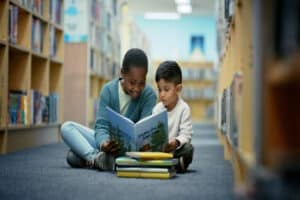Kiezer said it was approved by the Green Building Council and the South African Bureau of Standards approved it for safety.

A million reclaimed yoghurt tubs were used to build a library which was handed over to Nageng Primary School in Vosloorus, on the East Rand, yesterday.
The project was initiated and completed by Danone NutriDay to celebrate world literacy day today.
In April, Danone announced the no-fee paying school as the beneficiary of its NutriDay Tubs2Classrooms learning centre. Nageng Primary itself collected more than 15 000 Danone yoghurt tubs.

Excited pupils gathered outside the school’s assembly point to take part in the opening of the exclusive library. Danone partnered with Pick n Pay School Club and the Imperial Motus community trust organisation.
ALSO READ: Boosting literacy: Limpopo premier donates 300 books to Groblersdal library
Danone’s Leanne Kiezer said the initiative showcased the company’s impact journey and its commitment to leaving a positive mark in communities, as well as diverting waste from landfills.
“The official opening of this library is our investment in sustainability, knowing that the longevity of this structure will have a lasting impact, and will be benefiting generations to come,” she said.

According to Kiezer, 100 schools in Gauteng were activated and used as yoghurt tubs collection points.
“We basically taught them all about why it’s important to recycle their yoghurt tubs. And then the schools enter a competition where the school that collected the most tabs would win a cash prize from Danone.
ALSO READ: Extra study material and a whole library Now available on a bank app
“The narrative is all about that if you treat your plastic properly then it has the potential to have value. It can be turned into something useful, and that’s why it’s so important to make sure your plastic does not go into little or landfill, but rather that it goes into a purpose in a recycling stream to produce bricks.”
Kiezer said one million yoghurt tubs were collected, which contributed to 4 100 bricks used in the structure – with each brick taking 245 yoghurt tubs.

“So the brick itself is actually a very unique special brick,” she said. “It incorporates plastic. We took the yoghurt tubs and we grind them down into a granulite. So they are actually fine particles now. So 25% of this brick is made up of those yoghurt tubs.
“Then the white bits are polystyrene, which makes up 50% of the brick, and then the remaining 25% is the actual cement, the aggregate that holds it all together.”
ALSO READ: What makes a library ‘green’?
Kiezer said it was approved by the Green Building Council and the South African Bureau of Standards approved it for safety.
“It is inflammable and it’s remarkable because it’s actually much lighter than a typical brick of the same nature if it was fully cemented,” she said.
“It also has an insulating effect because naturally the polystyrene that’s inside this brick is offering that insulating effect.
“So when you do building, you usually put think pink or polystyrene into your roof to try and moderate the temperature of your building.
“But with these, that is not required because already the polystyrene is included.”

Nageng’s head girl Akani Mailula said the introduction of this library would enhance the quality of education in the school and the community.
The library provides a spacious environment along with a colourful setting stocked with 4 500 brand new books, individually wrapped with plastic, ranging from dictionaries, intermediate phase and adult reads.
Kiezer said every book had been catalogued, and was connected up to a computer system for ease of reference.






